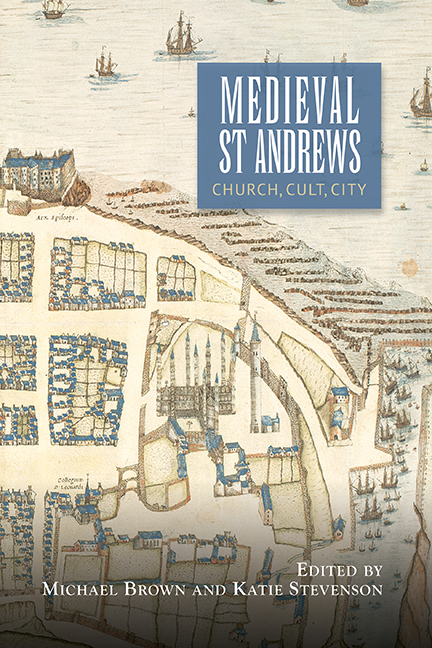Book contents
- Frontmatter
- Dedication
- Contents
- List of Illustrations, Charts and Tables
- Contributors
- Abbreviations
- 1 ‘Ancient Magnificence’: St Andrews in the Middle Ages: An Introduction
- 2 From Cinrigh Monai to Civitas Sancti Andree: A Star is Born
- 3 The Idea of St Andrews as the Second Rome Made Manifest
- 4 The Medieval Ecclesiastical Architecture of St Andrews as a Channel for the Introduction of New Ideas
- 5 When the Miracles Ceased: Shrine and Cult Management at St Andrews and Scottish Cathedrals in the Later Middle Ages
- 6 Religion, Ritual and the Rhythm of the Year in Later Medieval St Andrews
- 7 Living in the Late Medieval Town of St Andrews
- 8 The Burgh of St Andrews and its Inhabitants before the Wars of Independence
- 9 The Archaeology of Medieval St Andrews
- 10 Prelates, Citizens and Landed Folk: St Andrews as a Centre of Lordship in the Late Middle Ages
- 11 Augmenting Rentals: The Expansion of Church Property in St Andrews, c. 1400–1560
- 12 The Prehistory of the University of St Andrews
- 13 University, City and Society
- 14 The Medieval Maces of the University of St Andrews
- 15 Heresy, Inquisition and Late Medieval St Andrews
- Appendix 1 The St Andrews Foundation Account
- Appendix 2 The Augustinian' Account
- Appendix 3 The Boar' Raik
- Appendix 4 University of St Andrews Library, UYSL 110/6/4
- Index
- Miscellaneous Endmatter
5 - When the Miracles Ceased: Shrine and Cult Management at St Andrews and Scottish Cathedrals in the Later Middle Ages
Published online by Cambridge University Press: 28 April 2017
- Frontmatter
- Dedication
- Contents
- List of Illustrations, Charts and Tables
- Contributors
- Abbreviations
- 1 ‘Ancient Magnificence’: St Andrews in the Middle Ages: An Introduction
- 2 From Cinrigh Monai to Civitas Sancti Andree: A Star is Born
- 3 The Idea of St Andrews as the Second Rome Made Manifest
- 4 The Medieval Ecclesiastical Architecture of St Andrews as a Channel for the Introduction of New Ideas
- 5 When the Miracles Ceased: Shrine and Cult Management at St Andrews and Scottish Cathedrals in the Later Middle Ages
- 6 Religion, Ritual and the Rhythm of the Year in Later Medieval St Andrews
- 7 Living in the Late Medieval Town of St Andrews
- 8 The Burgh of St Andrews and its Inhabitants before the Wars of Independence
- 9 The Archaeology of Medieval St Andrews
- 10 Prelates, Citizens and Landed Folk: St Andrews as a Centre of Lordship in the Late Middle Ages
- 11 Augmenting Rentals: The Expansion of Church Property in St Andrews, c. 1400–1560
- 12 The Prehistory of the University of St Andrews
- 13 University, City and Society
- 14 The Medieval Maces of the University of St Andrews
- 15 Heresy, Inquisition and Late Medieval St Andrews
- Appendix 1 The St Andrews Foundation Account
- Appendix 2 The Augustinian' Account
- Appendix 3 The Boar' Raik
- Appendix 4 University of St Andrews Library, UYSL 110/6/4
- Index
- Miscellaneous Endmatter
Summary
BY the fifteenth century St andrew had been firmly established as the patron saint of the scots. His image adorned coins and royal seals at home, while abroad altars and fraternities dedicated to the saint formed the focus for the communal identity of scottish students and monks. Paradoxically, at the same time belief in the efficacy of the relics of st andrew, housed in their elaborate shrine in fife, was on the wane. This development was part of a broader western european trend in the later middle ages which saw a gradual decline in the importance and, perhaps as significantly, in the profits of long-established cathedral shrines. This decline was not indicative of a waning of interest in pilgrimage as an activity; in fact it may well have reached its peak in popularity in the two centuries between the first appearance of the black death and the reformation. The decline resulted from what richard dobson has termed the ‘widespread transfer of allegiance from the old to the new’ that characterised late medieval popular piety. In england ‘the new’ included shrines focused on marian and passion devotion, the most popular of which were located at walsingham and hailes, and those of a range of uncanonised ‘would be saints’ like henry vi (1423–71) at windsor and richard scrope (d. 1405) in york. dobson has explored the strategies that the monastic communities at two of england's more venerable shrines, those of st cuthbert at durham and thomas becket at canterbury, used to protect the status of their patron saints in this rapidly changing spiritual environment. this essay will investigate similar efforts by the cathedral chapter at st andrews to modernise the shrine of their patron saint, comparing the effectiveness of the techniques employed to those used by the custodians of other scottish cathedral shrines in the later middle ages.
The shrine of St Andrew in Fife was at its peak of popularity from the late eleventh to the late thirteenth century. It was in this period that the confident claims made by the religious community at St Andrews that they possessed a thriving shrine, frequented by an international clientele, receive some corroboration from Welsh and English sources. English visitors could still be found at the shrine on the eve of the Wars of Independence with groups of pilgrims recorded there in 1273 and 1285.
- Type
- Chapter
- Information
- Medieval St AndrewsChurch, Cult, City, pp. 84 - 98Publisher: Boydell & BrewerPrint publication year: 2017



